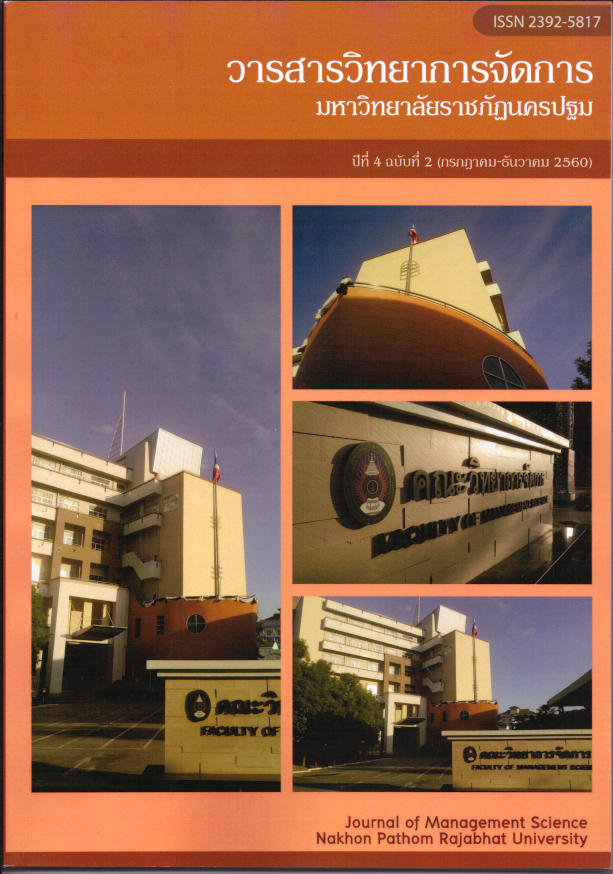แบบจำลองสมการโครงสร้างปัจจัยเสี่ยงของพฤติกรรมฉวยโอกาสจากผู้ค้าส่งที่มีอิทธิพลต่อการยุติความสัมพันธ์ระหว่างคู่ค้าภายในโซ่อุปทานผัก
Main Article Content
บทคัดย่อ
ดุษฎีนิพนธ์นี้มีวัตถุประสงค์เพื่อ (1) วิเคราะห์องค์ประกอบและตัวบ่งชี้ที่เกี่ยวข้องกับปัจจัยเสี่ยงของพฤติกรรมฉวยโอกาสจากผู้ค้าส่งที่มีอิทธิพลต่อการยุติความสัมพันธ์ระหว่างคู่ค้าภายในโซ่อุปทานผัก และ (2) พัฒนาแบบจำลองสำหรับอธิบายปัจจัยเสี่ยงของพฤติกรรมฉวยโอกาสจากผู้ค้าส่งที่มีอิทธิพลต่อการยุติความสัมพันธ์ระหว่างคู่ค้าภายในโซ่อุปทานผัก
การวิจัยครั้งนี้เป็นการวิจัยเชิงปริมาณโดยการสัมภาษณ์ผู้ปลูกผักบริโภคใบ 5 ชนิด ได้แก่ ผักคะน้า, ผักกวางตุ้ง, ผักบุ้งจีน, ผักต้นหอม และผักชี ในจังหวัดนครปฐมและราชบุรี จำนวน 146 ตัวอย่าง เครื่องมือที่ใช้ในการวิจัย คือ แบบสัมภาษณ์แบบมีโครงสร้างที่ผ่านการตรวจสอบค่าความเที่ยงตรงเชิงเนื้อหา (IOC) จากผู้ทรงคุณวุฒิจำนวน 7 ท่าน
ผลการวิจัย พบว่า โอกาสของการถูกฉวยโอกาสมีค่าน้ำหนักปัจจัยจากการกดราคารับซื้อผลผลิต (lx1 = 0.63) การชำระเงินค่าผลผลิต (lx4 = 0.55) การบิดเบือนข้อมูลผลผลิต (lx2 = 0.53) และการโก่งราคาปัจจัยการผลิต (lx3 = 0.48) ตามลำดับ ส่วนผลกระทบของการถูกฉวยโอกาสมีค่าน้ำหนักปัจจัยจากยอดขาย (ly1 = 0.57) กำไร (ly3 = 0.52) ความเชื่อใจ (ly4 = 0.51) ความเต็มใจในการขายผลผลิต (ly5 = 0.46) และค่าใช้จ่าย (ly2 = 0.40) ตามลำดับ และการยุติความสัมพันธ์มีค่าน้ำหนักปัจจัยจากการไม่ขายผลผลิตให้ผู้ค้าส่งที่เอาเปรียบ (ly6 = 0.62) การเปลี่ยนผู้ค้าส่งรายใหม่ (ly7 = 0.59) และการร้องเรียนกับหน่วยงานที่เกี่ยวข้อง (ly8 = 0.57) ตามลำดับ นอกจากนี้ การยุติความสัมพันธ์ได้รับอิทธิพลรวมเชิงบวกจากโอกาสของการถูกฉวยโอกาส (b = 0.99) อย่างมีนัยสำคัญทางสถิติ และการยุติความสัมพันธ์ยังได้รับอิทธิพลทางตรงเชิงบวกจากผลกระทบของการถูกฉวยโอกาส (b = 0.83) และโอกาสของการถูกฉวยโอกาส (b = 0.53) ตามลำดับ ในขณะที่ผลกระทบของการถูกฉวยโอกาสได้รับอิทธิพลรวมเชิงบวกจากโอกาสของการถูกฉวยโอกาส (g = 0.80) อย่างมีนัยสำคัญทางสถิติ
* นักศึกษาปริญญาเอก หลักสูตรปรัชญาดุษฎีบัณฑิต สาขาวิชาการจัดการโลจิสติกส์ มหาวิทยาลัยบูรพา 20131 ภายใต้การควบคุมของอาจารย์ ดร.ฐิติมา วงศ์อินตา
Corresponding author : ajsanti2008@gmail.com
Article Details
ทัศนะและข้อคิดเห็นของบทความที่ปรากฏในวารสารฉบับนี้เป็นของผู้เขียนแต่ละท่าน ไม่ถือว่าเป็นทัศนะและความรับผิดชอบของกองบรรณาธิการ
เอกสารอ้างอิง
กรมการค้าภายใน. (2558). ตลาดซื้อขายสินค้าล่วงหน้า.[ออนไลน์]. ค้นเมื่อ 26 มกราคม 2558. จาก https://mwsc.dit.go.th/Upload/web_old/Web_future/feature_market.htm.
กรมส่งเสริมการเกษตร. (2559). ภาพรวมการปลูกพืชทุกชนิด ปี 2558-2559. [ออนไลน์]. ค้นเมื่อ 26 มกราคม 2558. จาก https://www.agriinfo.doae.go.th/year59/plant/rortor/all.pdf.
สำนักงานคณะกรรมการพัฒนาการเศรษฐกิจและสังคมแห่งชาติ. (2554). แผนพัฒนาเศรษฐกิจและสังคมแห่งชาติ ฉบับที่ 11 พ.ศ. 2555-2559. [ออนไลน์]. ค้นเมื่อ 28 มกราคม 2558. จาก https://www.nesdb.go.th/download/article/article_20160323112431.pdf.
สำนักงานเศรษฐกิจการเกษตร. (2554). แผนพัฒนาการเกษตรในช่วงแผนพัฒนาเศรษฐกิจและสังคมแห่งชาติ ฉบับที่ 11 (พ.ศ. 2555-2559). [ออนไลน์]. ค้นเมื่อ 26 มกราคม 2558. จาก https://www.oae.go.th/download/document_plan/planAgi11_Sep55.pdf.
สำนักงานเศรษฐกิจการเกษตร. (2558). ยุทธศาสตร์การพัฒนาโลจิสติกส์และโซ่อุปทานภาคการเกษตร พ.ศ. 2556 - 2559. [ออนไลน์]. ค้นเมื่อ 28 มกราคม 2558. จาก https://www.oae.go.th/download/download_journal/2558/j_logistic56-59.pdf.
สำนักงานคณะกรรมการพัฒนาการเศรษฐกิจและสังคมแห่งชาติ. (2559). แผนพัฒนาเศรษฐกิจและสังคมแห่งชาติ ฉบับที่ 12 พ.ศ. 2560-2564. [ออนไลน์]. ค้นเมื่อ 28 มกราคม 2558. จาก https://www.nesdb.go.th/ewt_news.php?nid=6420.
สำนักงานเศรษฐกิจการเกษตร. (2559). แผนพัฒนาการเกษตรในช่วงแผนพัฒนาเศรษฐกิจและสังคมแห่งชาติ ฉบับที่ 12 (พ.ศ. 2560-2564). [ออนไลน์]. ค้นเมื่อ 28 มกราคม 2558. จาก https://www.oae.go.th/download/journal/development_plan2559.pdf.
Anderson, S. W., and Dekker, H. C. (2005). Management control of market transactions: the relation between transaction characteristics, incomplete contract design and subsequent performance. Management Science, 51 (16), 1734-1752.
Augustsson, A.L.M., Uddh-Soderberg, T.E. and Hogmalm, K.J. (2015). Metal uptake by homegrown vegetables – the relative importance in human health risk assessments at contaminated sites. Environmental Research, 138 , 181-190.
Bentler, P.M. and Chou, C.P. (1987). Practice issues in structural modeling. Sociological Methods and Research, 16 (1), 78-117.
Cherfi, A., Abdoun, S. and Gaci, O. (2014). Food survey: levels and potential health risks of chromium, lead, zinc and copper content in fruits and vegetables consumed in Algeria. Food and Chemical Toxicology, 70, 48-53.
Das, T.K. and Teng, B.S. (2001). Relational risk and its personal correlates in strategic alliances. Journal of Business and Psychology, 15 (3), 449-465.
Das, T.K. (2004). Time-span and risk of partner opportunism in strategic alliances. Journal of Managerial Psychology, 19 (8), 744-759.
Das, T.K. (2005). Deceitful behaviors of alliance partners: potential and prevention. Management Decision, 43 (5), 706-719.
Delerue-Vidot, H. (2006). Opportunism and unilateral commitment: the moderating effect of relational capital. Management Decision, 44 (6), 737-751.
Dewar, R. and Werbel, J. (1979). Universalistic and contingency predictions of employee satisfaction and conflict. Administrative Science Quarterly, 24 (3), 426-448.
Fishman, C. (2006). The Wal-Mart Effect: How the World's Most Powerful Company Really Works and How It's Transforming the American Economy. New York : Penguin Press.
Hair, J.F., Jr., Black, W.C., Babin, B.J. and Anderson, R.E. (2010). Multivariate Data Analysis. (7th ed.). Upper Saddle River, NJ : Prentice Hall.
Hallikas, J., Virolainen, V.M. and Tuominen, M. (2002). Understanding risk and uncertainty in supplier networks – a transaction cost approach. International Journal of Production Research, 40(15), 3519-3531.
Jap, D. S. and Anderson, E. (2003). Safeguarding inter organizational performance and continuity under ex post opportunism. Management Science, 49 (12), 1684-1701.
Joreskog, K. and Sorbom, D. (1999). LISREL 8 : Users' Reference Guide. Chicago : Scientific Software International.
Khan, O. and Burnes, B. (2007). Risk and supply chain management: creating a research agenda. The International Journal of Logistics Management, 18 (2), 197-216.
McCarter, M.W. and Northcraft, G.B. (2007). Happy together? insights and implications of viewing managed supply chains as a social dilemma. Journal of Operations Management, 25, 498-511.
Narayanan, V. G. and Raman, A. (2004). Aligning incentives in supply chains. Harvard Business Review, 82 (11), 94-102.
Nunnally, J.C. and Bernstein, I.H. (1994). Psychometric Theory. (3rd ed.). New York : McGraw-Hill.
Laeequddin, M., Sardana, G.D., Sahay, B.S., Abdul Waheed, K. and Sahay, V. (2009). Supply chain partners' trust building process through risk evaluation: the perspectives of UAE packaged food industry. Supply Chain Management: An International Journal, 14 (4),280-290.
Liu, Y., Li, Y., Tao, L. and Wang, Y. (2008). Relationship stability, trust and relational risk in marketing channels : evidence from China. Industrial Marketing Management, 37, 432-446.
Luo, Y. (2007). Are joint venture partners more opportunistic in a more volatile environment? Strategic Management Journal,. 28, 39-60.
Sitkin, S.B. and Pablo, A.L. (1992). Reconceptualizing the determinants of risk behavior. Academy of Management Review, 17 (1), 9-38.
Spekman, R.E. and Davis, E.W. (2004). Risky business: expanding the discussion on risk and the extended enterprise. International Journal of Physical Distribution and Logistics Management, 34 (5), 414-433.
Tahtinen, J. (2002). The process of business relationship ending – its stages and actors. Journal of Market-Focused Management, 5, 331-353.
Tahtinen, J., Blois, K. and Mittila, T. (2007). How the features of business relationships influence their endings. Journal of Business Market Management, 1 ( 3), 231-247.
Talluri, S., Narasimhan, R. and Chung, W. (2010). Manufacturer cooperation in supplier development under risk. European Journal of Operational Research, 207, 165-173.
Ting, S., Chen, C. and Bartholomew, D.E. (2007). An integrated study of entrepreneurs’ opportunism. Journal of Business and Industrial Marketing, 22 ( 5), 322-335.
Wathne, K.H. and Heide, J.B. (2000). Opportunism in interfirm relationships : forms, outcomes, and solutions. Journal of Marketing, 64 (4), 36-51.
Yu, R., Liu, Q., Liu, J., Wang, Q. and Wang, Y. (2016). Concentrations of organ phosphorus pesticides in fresh vegetables and related human health risk assessment in Changchun, Northeast China. Food Control, 60, 353-360.


